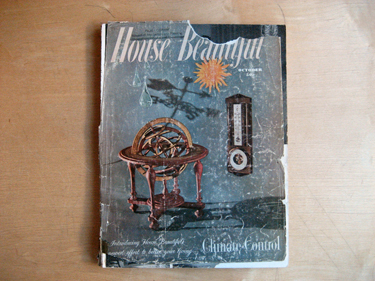A Machine for Climate:
The House Beautiful/AIA Climate Control Project
1949-1952
5.0 | House Beautiful
The House Beautiful Climate Control Project was completed in collaboration with the AIA. Each bi-monthly AIA bulletin featured a climatology report with data, charts, and design information architects could apply. The uniformity of the data made of the Bulletins a valuable resource. In a section of the September 1949 AIA entitled 'American Climates', Paul A. Siple wrote that 'The purpose of the House Beautiful Climate Control Project is to offer guidance to architects, community planners, consulting engineers, producers of building materials, and those interested in the development or regulation of house construction.'16
The reports were published in House Beautiful from October 1949 through early 1952 (AIA reports began in the Bulletin's September 1949 issue). The uniqueness of the project according to James Marston Fitch was that while climatology was not a new field, this collaboration was its first application to 'house and community design.'17 These reports featured a map outlining the relevant region for the data given, mean temperatures, solar information, precipitation, wind direction, and humidity information. Furthermore, design guidelines were provided, associated with the technical charts for site planning, interior planning, roof, foundation, mechanical and openings.
Each report focused on a different region of the United States. Simultaneously, each month House Beautiful published a simplified, non-technical summary or interpretation of this data, finding ways for the public to apply the suggestions of the magazine's contributors to their homes and landscapes. Researchers were asked to do three things: measure the climates of our principal population centers, tell us what each climate means in terms of human comfort, and prepare for each of these climates a set of performance specifications for comfortable houses (new or old).18 Often, House Beautiful combined these suggestions with other themes, most importantly, a campaign focused on an American identity and lifestyle, and creative means of establishing privacy. A regional-specific bent allowed for an emphasis on the uniquely special characteristics of a region while the scope of the project allowed for a uniformity of approach throughout the nation. House Beautiful's articles included articles on how climate-sensitive design could save money, how climate has played into design historically, the application of 'climate control' fabrics, how to manipulate sun and shade, and pace-setter homes for a variety of regions which the public could visit and view. Accompanying these articles in the same issues were articles on decorating with naturalistic furniture and colors, tracing the roots of an American style in folk art, and climate-related travel.

Photograph of the cover of the October 1949 issue of House Beautiful by author.
Questions for Consideration:
1. How did the House Beautiful articles help to establish the home as a component of the 20th century American city and the city as a component of the 20th century American nation?
2. What are the pros and cons of this two-fold approach to publication?
- The popular magazine
- The professional journal
3. What is the legacy of the House Beautiful/AIA Climate Control Project?
- How has urban-focused environmentalism which began in the mid-late 1960s resulted in part from the successes and failures these programs?
- Why are many of the points which informed these climatology studies still being viewed as new, challenging problems today?